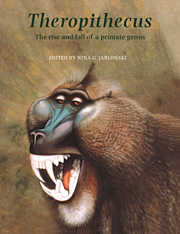Book contents
- Frontmatter
- Contents
- List of Contributors
- Preface
- Acknowledgements
- 1 Introduction
- PART I Fossil evidence and phylogeny
- PART II Biogeography and evolutionary biology
- 8 Climate change, biogeography and Theropithecus
- 9 African terrestrial primates: the comparative evolutionary biology of Theropithecus and the Hominidae
- PART III Anatomy of the fossil and living species of Theropithecus
- PART IV Behaviour and ecology of living and fossil species of Theropithecus
- Appendix I A partial catalogue of fossil remains of Theropithecus
- Appendix II Conservation status of the gelada
- Index
8 - Climate change, biogeography and Theropithecus
Published online by Cambridge University Press: 11 November 2009
- Frontmatter
- Contents
- List of Contributors
- Preface
- Acknowledgements
- 1 Introduction
- PART I Fossil evidence and phylogeny
- PART II Biogeography and evolutionary biology
- 8 Climate change, biogeography and Theropithecus
- 9 African terrestrial primates: the comparative evolutionary biology of Theropithecus and the Hominidae
- PART III Anatomy of the fossil and living species of Theropithecus
- PART IV Behaviour and ecology of living and fossil species of Theropithecus
- Appendix I A partial catalogue of fossil remains of Theropithecus
- Appendix II Conservation status of the gelada
- Index
Summary
Summary
Examination of the detailed chronological and geographical distribution of Theropithecus sites throughout Africa has indicated that the diversity and distribution of the genus were greatly influenced by global and regional climatic changes, as well as by interactions with predators and herbivores.
The small species range of the extant species Theropithecus gelada is not unusual compared with those of other anthropoid primates in Africa. What is unusual and in need of explanation is the very large range occupied by T. oswaldi in Africa during different parts of the Pleistocene.
If it is accepted that the known chronological ranges of fossil Theropithecus are representative of the actual distributions, then it can be determined that T. oswaldi occupied huge ranges (two or three biogeographic provinces) for only 32 per cent of the duration of the lineage. Theropithecus oswaldi lived for about 2.5 Ma, but only occurred in southern Africa and the Maghreb for about 0.8 Ma of this period. For the remainder of the time it was confined to tropical Africa.
The distribution patterns of extinct species of Theropithecus appear to be correlated with changes in climate in eastern Africa brought about by the rise of the ‘Roof of Africa’ during the Plio-Pleistocene. Other changes in species ranges seem to be related to global-scale climatic changes which resulted in latitudinal shifts in the boundary between the Ethiopian and the Palaearctic biogeographic realms, while still others may have been related to the radiations of Papio and Homo during the Pleistocene. Less likely causes of changes in the distribution of Theropithecus are represented by other herbivores, in particular the bovids and suids, although among the latter group the genus Phacochoerus may have contributed toward the shrinkage of Theropithecus territory.
- Type
- Chapter
- Information
- TheropithecusThe Rise and Fall of a Primate Genus, pp. 227 - 244Publisher: Cambridge University PressPrint publication year: 1993
- 16
- Cited by

